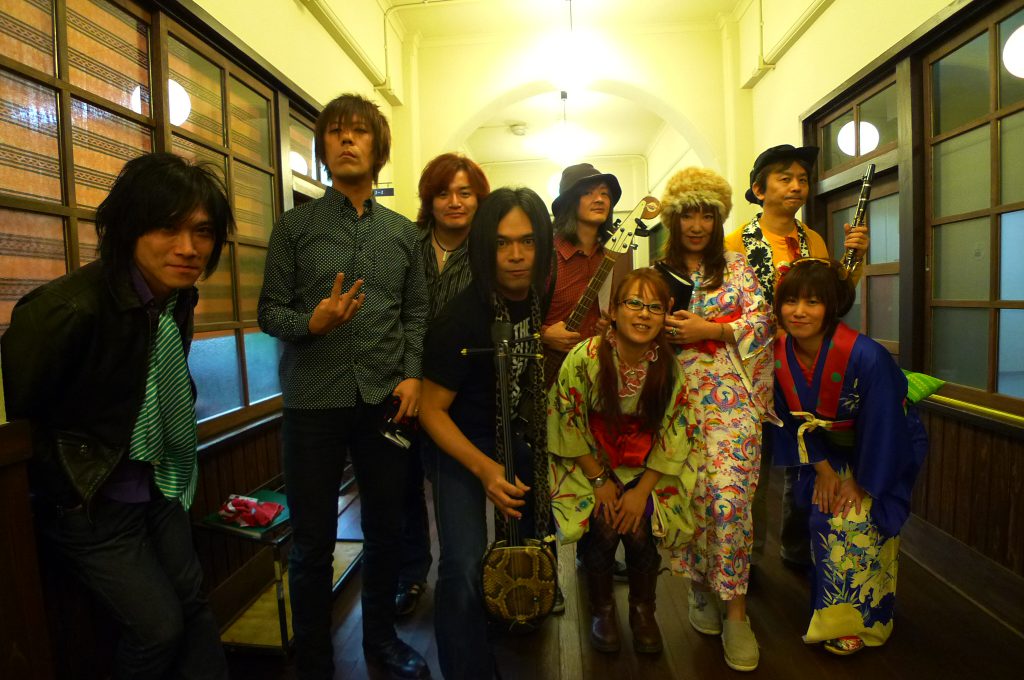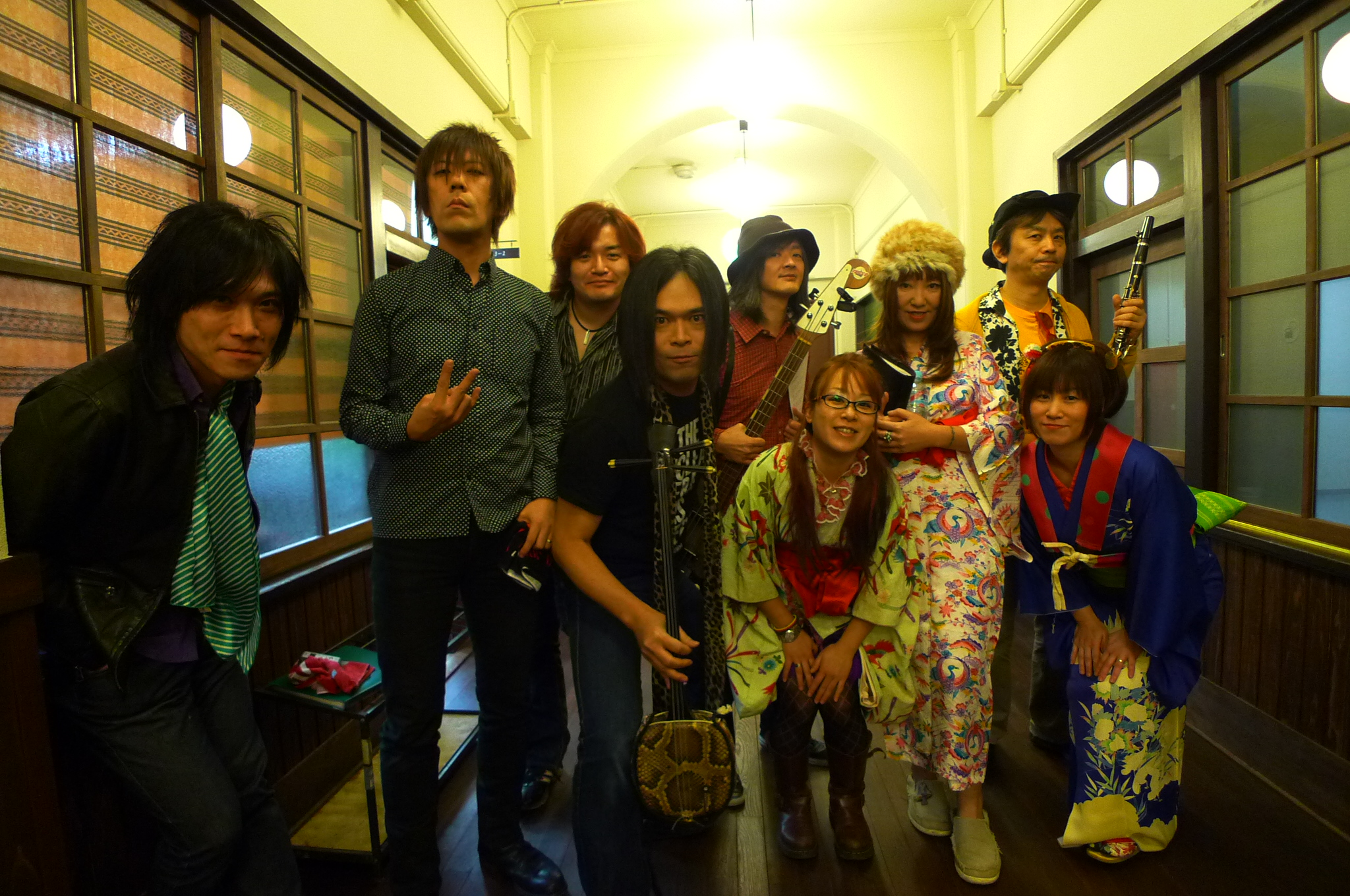SOUL FLOWER MONONOKE SUMMIT
| JP | ENG | KOR |
| SOUL FLOWER UNION |

1995年1月の阪神淡路大震災の直後、関西を活動拠点とするロック・バンド ソウル・フラワー・ユニオン は、伊丹英子の発案で、被災地での「出前慰問ライヴ活動」を開始。日本・沖縄・アイヌ・朝鮮の民謡、壮士演歌、労働歌、革命歌、はやり唄などをチンドン・ミュージック・スタイルで演奏する、 ソウル・フラワー・モノノケ・サミット として、ソウル・フラワー・ユニオンと同時並行活動を始める。
震災当時少なからず行なわれていた数多のチャリティー・コンサートと違い、何よりも事態の緊急性と被災地の現状を最優先した手作りの演奏活動は、現地ボランティア・スタッフらとの密な連携により、継続的に行なわれている。震災後の一年間だけでも、その演奏回数は優に100回を越える。また、時を同じくして伊丹英子によって設立されたソウル・フラワー震災基金も、他の既成組織に基金を委ねるのではなく、現地の実状を精査した上で、責任をもって直接、施設や現地ボランティア・スタッフに渡すという、現場の状況を正確に見据えた現実的にコミットする方法を選んでいる。
震災直後の当初、ライフラインが寸断された被災地で演奏する為、エレキ・ギターを沖縄の三線(さんしん)に、マイクをメガホンに変え、チンドン太鼓やチャンゴ、アコーディオン、クラリネットといった、電気を必要としない楽器を使用。年輩や子供達へ向けて選出された独自解釈を加えた雑多なレパートリーは、近世日本音楽の闇部を射抜く、「闇のジュークボックス」とでも形容できる新芸能へと昇華させている。そして、多くの出逢いを生んだ被災地での活動を通して、<満月の夕><あまの川><潮の路><荒れ地にて><そら>といった、ソウル・フラワー・ユニオンの数々の名曲が誕生している。
1996年にファースト・アルバム『アジール・チンドン』を、1997年にセカンド・アルバム『レヴェラーズ・チンドン』を、2006年には、待望されていた9年ぶりのサード・アルバム『デラシネ・チンドン』をリリースしている。
2007年、新たな米軍基地建設が計画される沖縄・辺野古のビーチにて ピース・ミュージック・フェス を企画・出演。 その模様を記録した、初のライヴDVD『ライヴ辺野古』を2008年にリリースしている。
被災地に始まり、障がい者イベント、寄せ場(ドヤ街)、市民運動、反戦運動の現場など日本全国の様々な祭りや、北朝鮮・平壌(96年)、中国返還直後の香港(97年)、ベトナム・ダナン(97年)、フィリピン・スモーキーマウンテン(97年)、東ティモール独立祝賀祭(02年)、フランス・ツアー(02年)、台湾(04年)、ヨルダン・パレスチナ難民キャンプ(05年)、台湾(13年)などなど、国内にとどまらず、唄と踊りが熱望されるヤチマタで祭りを創出し続けている。
2013年現在、メンバーは、中川敬(唄&三線)、伊丹英子(島太鼓、チャンゴ、三板)、奥野真哉(アコーディオン)、大熊ワタル(クラリネット)、林道代(チンドン太鼓)、河村博司(ベース)、伊藤孝喜(ドラム)、中里かおり(ピアニカ)らを中心に活動している。
| JP | ENG | KOR |
| SOUL FLOWER UNION |
SOUL FLOWER MONONOKE SUMMIT
1995: The Great Hanshin-Awaji Earthquake occurred in January. The Kansai-based rock ‘n’ roll band Soul Flower Union began giving live performances at the earthquake site in order to console the victims. The plan for these performances was instigated by Itami Hideko. Under the new name Soul Flower Mononoke Summit they began to play a chindon based music style which included Japanese, Okinawan, Ainu, Korean folk music, soshi enka (old comic songs of freedom fighters), labour songs, revolutionary songs, popular music and other styles.
Their performances gave priority to the urgency of the situation and its present condition, and so were different from other charitable concerts which were going on just after the earthquake. These performances continued in conjunction with the co-operation of local volunteer staff. During the year following the earthquake they played well over a hundred times.
At the same time as these activities were going on, Itami Hideko founded the Soul Flower Earthquake Fund. This was different from other established organisations in that the details of each situation were investigated and responsibility was taken for the allocation of money directly to institutions or to local volunteer staff, instead of it being donated to established organizations. They chose their method of commitment through an accurate and realistic understanding of the situation at the earthquake site rather than shouting and raising their voices for aid.
In order to play at the earthquake site, where all services were completely cut off, they played sanshin instead of electric guitar, used megaphones instead of microphones, chindon drums, Japanese drums, changgo, accordion and other instruments which did not require the use of electricity. Also, they had a varied repertoire, including their own interpretations of other songs, which they performed for the elderly and for children. This can be called the “ukebox of darkness” which shoots through the darkness of Japanese modern music and is sublimated as a new performing art.
In January 1996, the year after the earthquake, Soul Flower Mononoke Summit released their first album ‘Asyl Ching-Dong‘.
1997: Their second album ‘Levelers Ching-Dong‘ was released.
Since playing at the earthquake site they went on to do various other events including festivals all over Japan and events for the disabled, playing at cheap lodging-house districts, for citizens’ movements, and anti-war movements. Also, they went to Pyongyang in North Korea (1996), Hong Kong after its reversion to China (1997), Da Nang in Vietnam (1997), Smoky Mountain in the Philippines (1997), the East Timor independence celebrations (2002), France (2002), Taiwan (2004), Palestinian refugee camps in Jordan (2005), and other places. They do not just stay in Japan but continually create festivals at crossroads where people are desperate for songs and dance.
2006: In June, they released their third album and the first for nine years, ‘Deracine Ching Dong‘.
2007: In February, they planned and then played at a music festival on Henoko beach in Okinawa which is where there are plans to build a new US military base.
2008: In March, they released their first live DVD ‘Live Henoko‘.
| JP | ENG | KOR |
| SOUL FLOWER UNION |
소울 플라워 모노노케 서밋 SOUL FLOWER MONONOKE SUMMIT
1995년1월,한신대지진. 관서지방을 활동거점으로 하는 록밴드 소울 플라워 (Soul Flower Union) 유니언은, 이타미 히데코의 발안으로 피해지에서의 라이브활동을 시작. 칭동 뮤직스타일로 일본,오키나와,아이누,조선의 민요,노동가,혁명가등을 연주하는 어쿠스틱 스타일을 그들은 <소울 플라워 모노노케 서밋> (Soul Flower Mononoke Summit)이라고 이름 붙임.
지진당시 적지않게 진행 되었던 여느 채리티 콘서트와는 달리 무엇보다도 사태의 긴급성과 피해지의 현황을 최우선으로 한 그들의 연주활동은 현지의 자원봉사자들과 의 긴밀한 연락을 토대로 지속적으로 진행되고 있음. 재난 이후 1년간 그들의 연주횟 수는 100회를 넘음. 같은 시기에 설립한 소울 플라워 재난기금도 기타 기금 조직에 기금을 그저 전달하는 차원이 아니라 현지의 상황을 조사한 후에, 직접 구호시설이나 자원봉사자들에게 기금을 전달하는 방법을 택함.
한신대지진의 다음 해인 1996년 1월에, 소울 플라워 모노노케 서밋으로서의 첫 앨범 <아질 칭동> (Asyl Ching-Dong)이 발매.
1997년, 두번째 앨범 <레베라즈 칭동>(Levelers Ching-Dong)이 발매.
이후, 피해지에서 시작해 시민운동, 반전운동 등 일본 전국에서의 여러축제와 공연, 북한 평양공연(96년), 중국반환직후의 홍콩공연(97년), 베트남 다난(97년), 필리핀 스모키 마운틴(97년), 동티모르독립축하공연(02년), 프랑스 투어(02년), 타이완(04년), 요르단 팔레스타인 난민캠프(05년)등 국내에 국한하지 않고 음악과 춤이 있는곳 어디에서건 그들의 활동을 지속해 나가고 있음.
2006년 6월, 9년만에 3번째 앨범 <데라시네 칭동> (Deracine Ching Dong)을 발매.
2007년 2월, 새로운 미군기지건설이 계획되어있는 오키나와_헤노코비치에서 MUSIC FESTIVAL를 기획_출연.
트래드, 소울, 재즈, 펑크, 레게, 라틴, 민요, 칭동, 록큰롤등, 다양한 음악에의 시도와 그것을 실제로 구현화시키는 축제적인 라이브는, 일본최강의 얼터너티브 믹스처 록큰롤로 인정받고 있으며, 유일무이한 존재로서 국내외를 불문하고 높은 평가를 받고있음.

